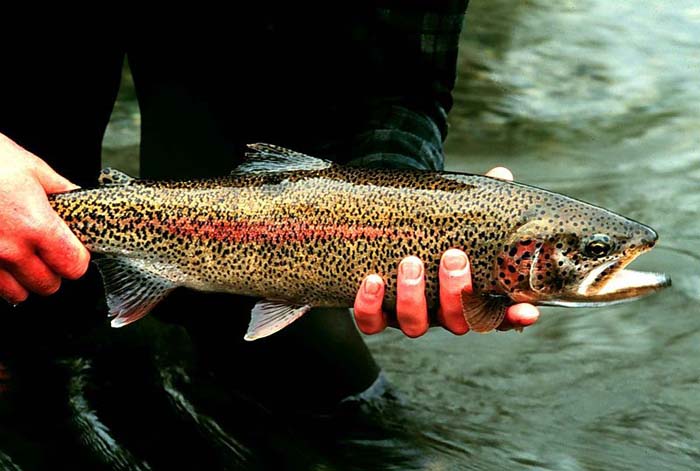
Fly caught rainbow trout [Oncorhynchus mykiss]. Photo by Lisac Mark, U.S. Fish and Wildlife Service. A commons image.
It’s time for a new casting technique
By Skip Clement
[dropcap]N[/dropcap]ymphing, swinging flies, dapping or Tenkara style fishing are not a few of my favorite fly fishing thing to do. But when that’s what’s playing in the theatre near me, I’m all in. When the surface slurping is on, I get the hint. It’s also time for a different casting technique.
The hatches Angie and I were watching on the Eberle Farmstead’s Cannon Creek were regular arrivals but small in numbers, but only a fool would ignore that the trouts, rainbow and brown with a rare brookie washed down during hard rains from feeder streams that come off the mountain, required a different fly fishing approach.
You cannot successfully attract a trout take with dries using a streamer fly cast, chuck metal or bait at it
My first classroom on how to capture rising fish was with Louie Castellini 50 years ago. Louie was a naturalized citizen from Italy who had earned his path to citizenship as a partisan fighter helping the Allied Forces during WWII. Although remaining heavily accented throughout his life, he became a metallurgical engineer with United States Steel in Pittsburgh, Pennsylvania. A long ago enterprise of a famous city built on the backs of immigrants.
When we met our lives became intertwined. On a June day in the late 1960s, we were both independently fishing south of the Pine Creek Gorge, a body of water that empties volumes of freshwater into Northeast Pennsylvania from New York State. One of the rivers that emerges is Pine Creek, a significant fishery itself and a worthy float tripper venue. Lots of trout with some smallies, but Pine’s most valuable connection to trout was, and still is, the Blue Ribbon tributaries of Slate Run and Cedar Run – both productive trout fisheries. Louie spotted me in mid-angst on Big Pine.
That’s no ten! He said
Louie described my dry fly casts to rising animals of the mykiss class as one’s and two’s. A metaphor for competitive Olympic diving scores in which a ten was as good as you can get – the splash non-existent. I finally picked up on a few things watching him. His backcast was normal, but a little – almost imperceptibly lower than usual, and his forward cast was approximately 45° skyward from parallel with no intent for distance. Instead, his casts all landed fly first and softly. The fly was on the water and the line eventually in the swing but no quick mend. The fly placement never long never unnaturally dragging, and all of his takes were at the end of the drift.
If no bite, his slow-hi stick and close-in pick up did not spray water, and the pattern of delivery repeated with the fly terminating its drift at a slightly different coordinate each time. He’d take a step forward each time, like English spey casters.

Cedar Run Inn – many fond memories of trout, bass, and friends now past. Photo Cedar Run Inn.
Land like a butterfly and never sting like a bee
What was going on was that Louie wanted the fly landing on the water first [an Olympic diving score of “10”] and that during the drift the fly was not “pulled” unnaturally by the current – like the infamous immediate mend that would produce dragging instantly.
Snap roll
On a recent catch-up call to my friend of 60 years, Ed Brennan, whom I fished with many times – he brought up the problem of casting to rising trouts – saying it was still a conundrum after all these years. I said, watch the video by an Englishman named Edwards – it’s called something like snap roll cast? It’s a way I learned in the 1960s – you remember Louie… my friend from Pittsburgh? The whole idea is not to have the fly and fly line hit the water at the same time. Kur-plunk is bad when fishing risers, and not too good ever – except for curious fish like cobia and sailfish.

